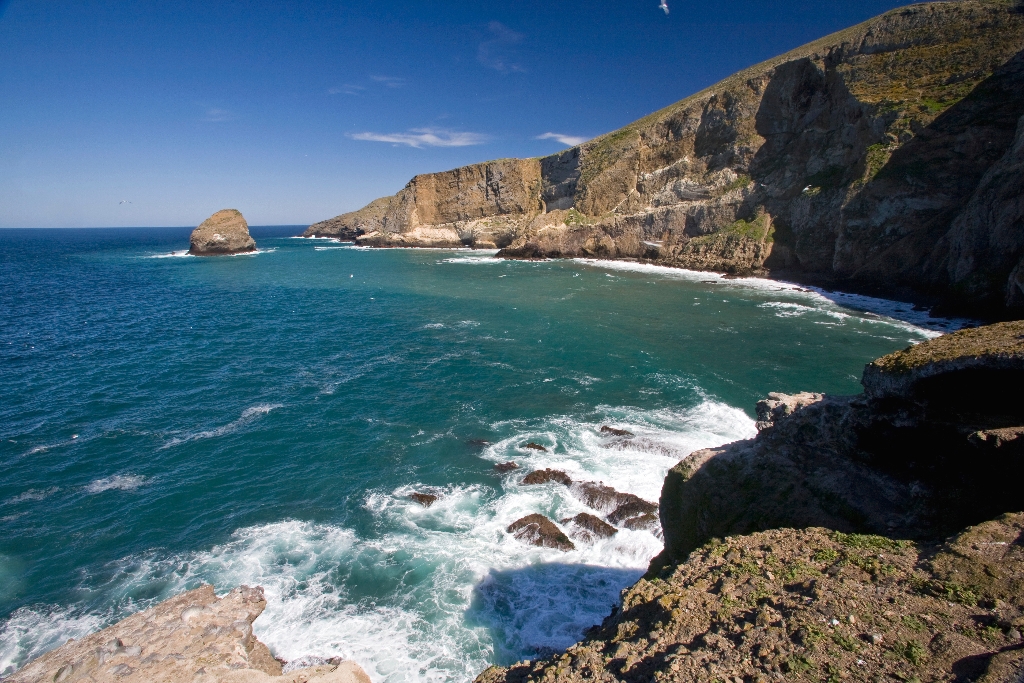
This overlook of Elephant Seal Cove is 2.5-miles, round trip from the visitor center. As its name implies, elephant seals can be seen along the rocky shoreline.
Stop 7: Arch Point Tour-An Ocean Park and Sanctuary
From this vantage point, one has the opportunity to gaze upon another part of the park: the marine environment. One nautical mile of water around each island is part of Channel Islands National Park, and the six nautical miles around each island form Channel Islands National Marine Sanctuary.
Within this ocean realm, one often sees or hears California sea lions, northern elephant seals, or harbor seals. The island's isolated shoreline offers these pinnipeds an ideal combination of safety from predators and freedom from human disturbance, making the island an ideal place to rest, breed, and pup.
But even Santa Barbara Island's isolation could not always protect these and other sea mammals from human predation. As early as the late 1700's, fur hunters were exploiting sea otters, fur seals, elephant seals, and sea lions for their fur, hides and oil. Sea mammal hunting ended in the early 1900's and laws like the Marine Mammal Protection Act now protect these species. Today, elephant seals, sea lions, and harbor seals regularly breed along the island's shoreline. In this isolated environment, their protected populations are recovering from centuries of slaughter. Unfortunately, the sea otter has not yet returned.
These pinnipeds, along with over 800 other marine species, also depend on the extensive kelp forests found in these waters for food, shelter, and protection- from foraging nudibranchs, to grazing snails, to fish seeking refuge, to whales feasting on plankton. Kelp is a type of algae that, under ideal conditions (cold, nutrient-rich water), is one of the fastest growing organisms on Earth-it can grow two feet per day.
While urban and industrial development has altered much of the southern California coastal mainland, the isolated islands contain the most undisturbed stretches of coastline in this region, providing some of the best conditions for kelp forests and their inhabitants.
Kelp forests don't just benefit marine species-they benefit us as well. Not only do we eat some of the animals that depend upon the kelp forest, but everyday products like ice cream, salad dressing, and even toothpaste also use a little bit of seaweed as well. Kelp is harvested for a natural ingredient called algin, which is used as a suspending, stabilizing, emulsifying, gel-producing, and film-forming additive in more than 70 commercial products. In addition, marine plants and algae such as kelp provide Earth with 80 percent of its oxygen.
Despite these benefits, human activities have placed the kelp forest and its inhabitants in jeopardy. Pollution and over-harvesting of marine species have altered the kelp forest ecosystem, and kelp forests in southern California today cover less than half the area they covered at the turn of the 20th century.
However, with the establishment of marine protected areas (MPAs), improved pollution controls, fishing regulations, and increased research and public education, some of these problems have been corrected.
Within the park and sanctuary, this network of MPAs provides a refuge for sea life, as well as opportunities for recreation, education, and science. In 11 marine reserves (including one on Santa Barbara Island's southeastern side), recreational fishing and commercial harvesting are prohibited; limited fishing and harvesting are allowed in two marine conservation areas. The MPAs total 318 square miles, the largest such network off the continental United States and an important part of a larger, worldwide effort to conserve natural, historic, and cultural marine resources.
Park Protection
In 1938, Santa Barbara Island was proclaimed a national monument to protect, preserve, and teach us about the island's fragile resources and unique past. This distinction was reaffirmed and strengthened in 1980, when the island was included in the newly established Channel Islands National Park. By understanding these resources and the role isolation plays on these islands, the National Park Service can preserve them for future generations to study and enjoy.
The National Park Service needs your help as well. We encourage you to explore and learn more about Santa Barbara Island and the rest of the Channel Islands-but don't stop there. In recognizing the importance of these islands, take your awareness to the action level. Make every effort to preserve the plants, animals, and artifacts found not only within this park, but throughout the world as well.
Is there something we missed for this itinerary?
Itineraries across USA


















































